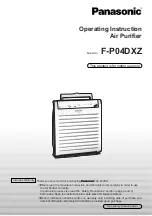
-6-
When unpacking, make sure that all of the
standard equipment is present and that there
is no transportation damage.
Before preforming any work on the
machine itself, disconnect the power plug.
ATTACHING THE VACUUM HOSE
Connect the 35-mm vacuum hose (standard
equipment) onto the canister’s hose port by
sliding the wider end of the hose onto the port
then turning it to the right slightly to lock it in place.
The 35-mm hose can be connected to optional
accessories, including the Bosch VAC011
wand kit and the dust extraction hoods on
various power tools and accessories, including
those on Bosch router, planer, grinder, sander,
jigsaw, and hammer/drill tools and accessories.
The canister’s hose port also accept many
other vacuum hoses, including most 1-1/4”
hoses, 1-1/2” hoses, 2-1/2” hoses and other
Bosch hoses. (See Accessories, page 12 & 13)
DUST COLLECTION OPTIONS
There are four dust collection options: plastic
bag, paper bag, slurry bag or no bag.
• The filter cartridges must be installed
whether or not any of the bags are used.
Dry Vacuuming Notes:
• When dry-vacuuming such materials as dust
from drywall, plaster, cement, soot, and flour,
a dust bag should be inserted.
• Using a paper or slurry dust bag extends the
amount of time the unit operates at high
performance and extends the amount of time
it takes for the filter cartridge to become
clogged.
• A plastic bag can handle a heavier load
without tearing than the paper or slurry bags.
• Using any of the three types of Bosch dust
bags also makes waste disposal much
easier, eliminating the cloud of dust that is
created when canister contents are simply
poured out, helping to protect you and the
environment from exposure to the unwanted
particles and debris.
Wet Vacuuming Notes:
• The VAC022 heavy-duty wet/dry bags can
be used when vacuuming wet materials.
They are ideally suited for slurry-suction
applications.
• The VAC013 paper bags should not be used
when wet vacuuming because the water will
cause the bag to come apart.
• The VAC023 plastic bags should not be used
when wet vacuuming because the bag may
tear when removed if it is fully loaded with
liquid.
• See WET VACUUMING section for more
information.
INSTALLING A DUST BAG
1. Unlock the canister latches and remove the
control unit.
2. Properly position the rotary air valve for the
dust collection to be used, according to
(Fig. 3).
3. Grasp a new dust bag at the flange. Push it
over the bottom of the internal port hose first
and then over the catch on the top of the
internal port hose. Make sure that the full
length of the dust bag faces against the
inner wall of the canister (Fig. 4).
4. Plastic bag only – If plastic bag is used,
wrap the upper edge of the plastic bag over
all four sides of the rim at the top of the
Assembly & Preparation
CANISTER LATCH
CANISTER
HOSE PORT
VACUUM
HOSE
DUST BAG
FIG. 2
BM 2610024876 04-12_BM 2610024876 04-12.qxp 4/5/12 9:14 AM Page 6







































